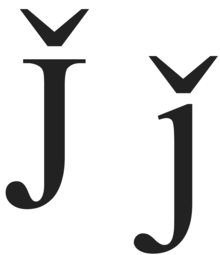J̌

J with caron in Doulos SIL
J̌ (minuscule: ǰ) is a letter of the Latin alphabet, derived from J with the addition of a háček. It is used in some phonetic transcription schemes, e.g. ISO 9, to represent the sound [dʒ]. It is also used in the Latin scripts or in the romanization of various Iranian and Pamir languages (Avestan, Pashto, Yaghnobi, and others), Armenian, Georgian, Berber/Tuareg, and Classical Mongolian.[1] The letter was invented by Lepsius in his Standard Alphabet on the model of š and ž to avoid the confusion caused by the ambiguous pronunciation of the letter j in European languages.[2]
References
- ↑ "Transliteration Systems for Uyghur-Mongolian or Vertical or Old Script". Tibetan and Himalayan Library.
- ↑ Lepsius, Richard (1863). Standard Alphabet for Reducing Unwritten Languages and Foreign Graphic Systems to a Uniform Orthography in European Letters. London: Williams & Norgate. p. 10.
This article is issued from
Wikipedia.
The text is licensed under Creative Commons - Attribution - Sharealike.
Additional terms may apply for the media files.